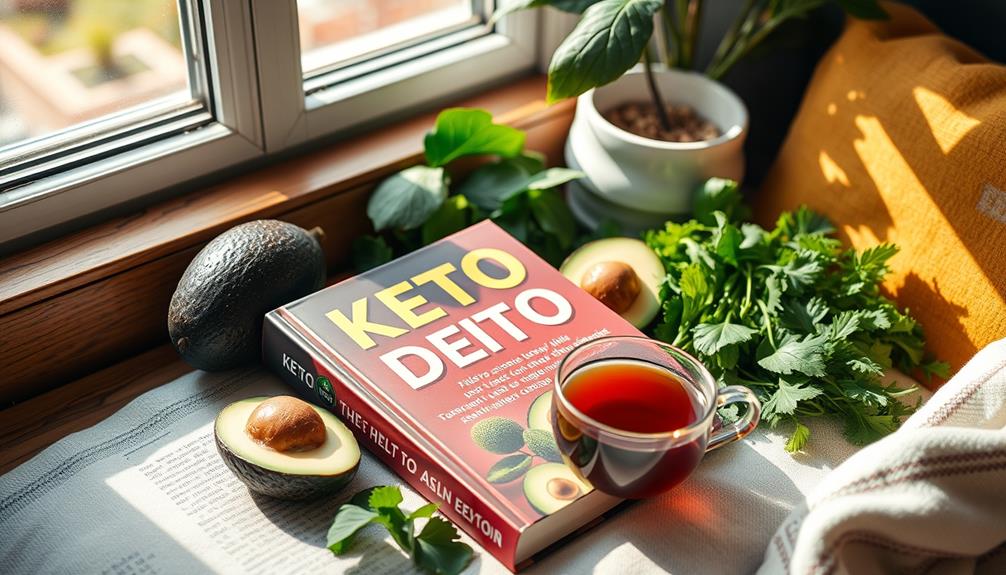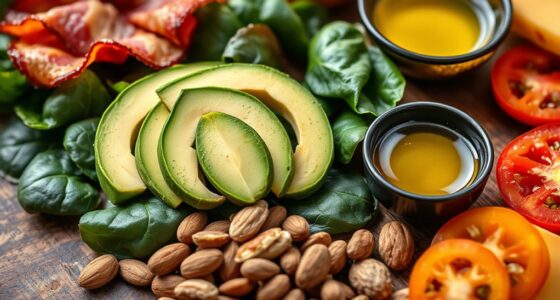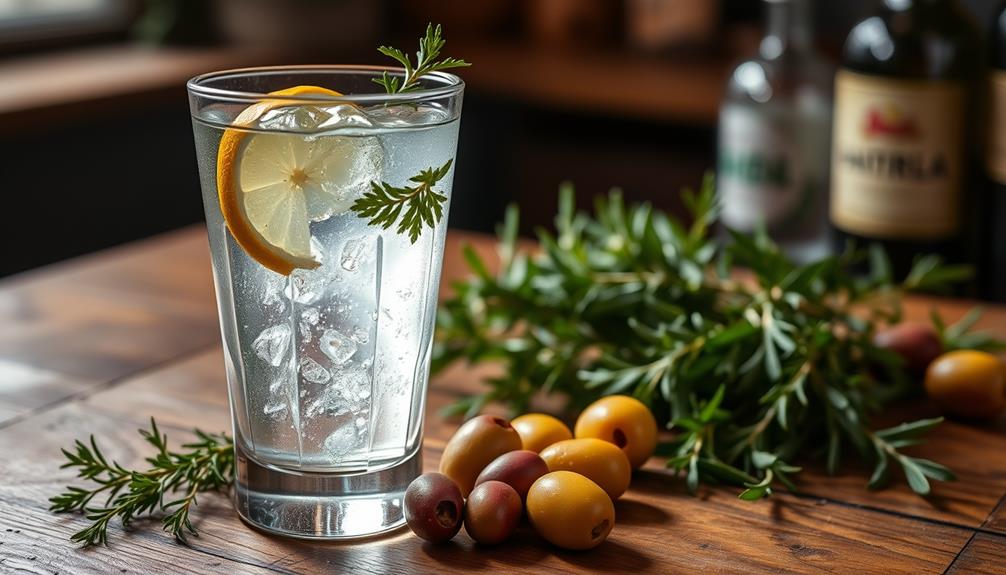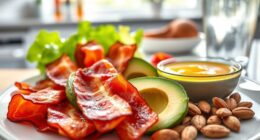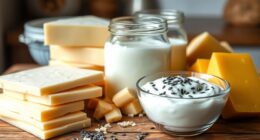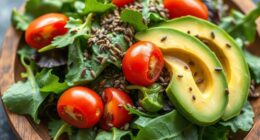Mastering the art of the keto plate is all about creating meals rich in healthy fats while keeping carbs in check. Focus on high-fat proteins like fatty cuts of meat and avocados, alongside non-starchy vegetables like broccoli and leafy greens. Aim for a meal balance of about 70-75% fats, 20-25% protein, and 5-10% low-carb veggies. Avoid grains, sugary fruits, and processed snacks to maintain ketosis. With quick techniques like grilling and roasting, you can whip up tasty dishes fast. There's plenty to explore on how to keep your meals exciting and nourishing for your keto journey.
Key Takeaways
- Focus on a balance of healthy fats (70-75%), moderate protein (20-25%), and low-carb vegetables (5-10%) for optimal ketosis.
- Prioritize high-fat proteins, non-starchy vegetables, and healthy fats while avoiding grains and sugary foods to maintain low carb intake.
- Master carbohydrate counting and understand net carbs to prevent unintentional carb overload and stay in ketosis.
- Incorporate antioxidant-rich foods, like celery juice, to enhance overall health while adhering to keto principles.
- Plan meals in advance to avoid high-carb snack choices and ensure nutrient balance in your diet.
Understanding the Keto Plate

When you plunge into the world of the Keto Plate, you're embracing a dietary approach that prioritizes low carbohydrates and high fats to trigger ketosis, a state where your body burns fat for energy instead of carbs.
This method is gaining popularity for its potential weight loss benefits and overall health improvements. To succeed, you'll need to master carbohydrate counting and understand net carbs, which are essential for maintaining balance in your meals.
Proper meal planning is vital, ensuring you get the necessary nutrients while adhering to keto principles. Incorporating foods that are rich in antioxidants, like celery juice, can enhance your overall health while following a keto diet.
Food Selection Guidelines

How do you choose the right foods for your Keto Plate? Start by focusing on high-fat proteins, non-starchy vegetables, and healthy fats. Include foods like fatty cuts of meat, leafy greens, and avocados. Avoid high-carb items to maintain ketosis.
Here's a quick reference table to help you:
| Allowed Foods | Foods to Limit | Foods to Avoid |
|---|---|---|
| Fatty meats | Whole grains | Sugary fruits |
| Leafy greens | Starchy vegetables | Processed snacks |
| Avocados | Certain legumes | Sugary drinks |
Meal Composition Essentials

Choosing the right foods lays the groundwork for understanding meal composition on your Keto Plate. You want to aim for a balance that emphasizes healthy fats, moderate protein, and low-carb vegetables.
Incorporating elements of nutrition management can further enhance your meal planning. Ideally, fats should make up about 70-75% of your daily intake, while protein accounts for 20-25%.
Incorporate high-fat sources like avocados and fatty cuts of meat, along with non-starchy veggies like leafy greens and broccoli. Keeping carbs to around 5-10% of your intake is essential, so avoid grains and starchy vegetables.
Sample Meals and Techniques

Crafting delicious meals on your Keto Plate can be both satisfying and easy with the right recipes and techniques. Here are some sample meals you can try, along with preparation methods that keep things simple:
| Meal | Ingredients | Cooking Technique |
|---|---|---|
| Grilled Chicken Salad | Chicken, avocado, broccoli | Grilling |
| Salmon with Asparagus | Salmon, asparagus, olive oil | Roasting |
| Beef Stir-Fry | Beef, cauliflower rice, peppers | Stir-frying |
Quick preparation methods like grilling, roasting, and stir-frying not only enhance flavors but also support your weight loss goals. By mixing and matching these meals and techniques, you'll enjoy variety while staying true to your keto lifestyle.
Common Mistakes and Myths

Many people diving into the keto diet often make common mistakes that can derail their progress. One frequent error is inaccurately tracking macros, which might lead to unintentional carb overload.
Additionally, individuals may overlook the importance of hydration, a key factor in kidney health, which can impact their overall well-being while on keto kidney health maintenance.
You might also underestimate the importance of incorporating enough healthy fats, thinking low-fat options are still acceptable.
Another pitfall is neglecting meal planning, causing you to grab high-carb snacks during busy days.
Additionally, myths persist that the keto diet isn't sustainable long-term or that it's unhealthy.
In reality, when done correctly, keto can promote weight loss and improve mental clarity.
Stay informed, track your food accurately, and embrace meal prepping to avoid these mistakes and misconceptions, ensuring a successful keto journey.
Frequently Asked Questions
How Does the Keto Diet Affect Athletic Performance?
The keto diet can impact your athletic performance in various ways.
While some athletes experience improved endurance and fat utilization, others might struggle with high-intensity activities due to lower glycogen stores.
You'll need to adjust your training and possibly cycle carbs for ideal results.
Pay attention to your body's reactions and energy levels, and consider consulting a nutritionist to guarantee you're meeting your performance goals while following the ketogenic principles.
Can I Drink Alcohol on a Keto Diet?
Imagine traversing a dense forest, where every step counts.
When it comes to drinking alcohol on a keto diet, you can sip cautiously. Opt for low-carb options like spirits or dry wines, but be mindful of hidden sugars.
Stay aware, as alcohol can affect your ketosis and hydration levels. Moderation is key; too much can derail your progress.
What Are the Best Snacks for a Keto Diet?
When you're snacking on a keto diet, focus on options that are low in carbs and high in healthy fats.
Great choices include nuts, cheese, olives, and avocado slices. You can also enjoy hard-boiled eggs or celery sticks with cream cheese.
If you want something sweet, try dark chocolate with a high cocoa content.
Always check the labels to avoid hidden sugars and carbs, ensuring your snacks fit within your daily macros.
How Long Does It Take to Enter Ketosis?
Entering ketosis typically takes about 2 to 7 days, depending on your individual metabolism, activity level, and dietary choices.
To speed up the process, you should limit your carb intake drastically, increase your healthy fat consumption, and stay hydrated. Regular exercise can also help deplete glycogen stores more quickly.
Is Intermittent Fasting Compatible With a Keto Diet?
You might wonder if combining intermittent fasting with a keto diet truly works. The answer is a resounding yes!
Both approaches emphasize fat burning, making them a powerful duo for weight loss and health. When you fast, your body taps into stored fat for energy, aligning perfectly with ketosis.
Just remember to maintain your low-carb intake during eating windows to maximize benefits, and you'll likely find impressive results on your health journey.
Conclusion
As you wrap up your journey into mastering the Keto Plate, remember that it's not just about what you eat, but how you enjoy it. Embrace the low-carb, high-fat lifestyle, and let your taste buds dance like it's 1999! With the right food choices and preparation techniques, you'll create satisfying meals that fuel your body and mind. So, plunge in, experiment, and watch as you transform your health—one delicious plate at a time! As you continue on your journey, remember that mastering weight loss is not just about restricting calories, but about finding balance and nourishing your body with the right nutrients. With the Keto Plate, you’ll discover a whole new world of delicious, wholesome foods that support your weight loss goals. Embrace this new way of eating and enjoy the transformation of not only your health, but also your relationship with food.



